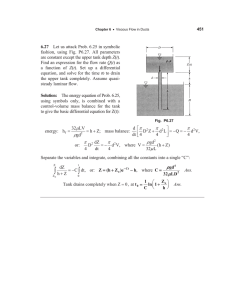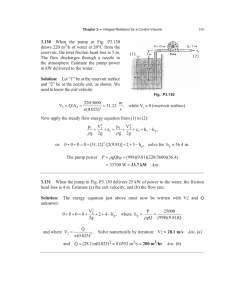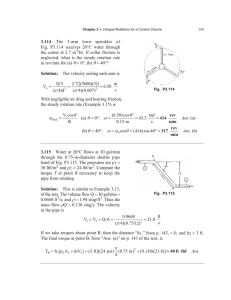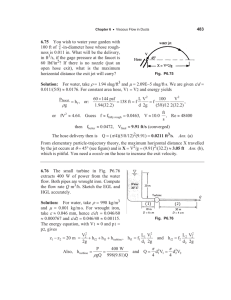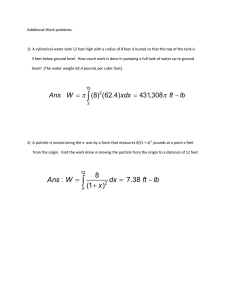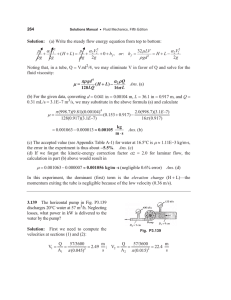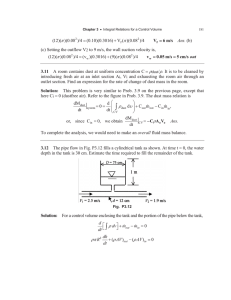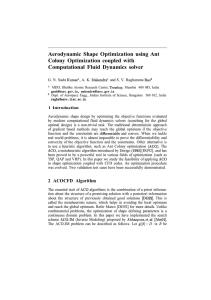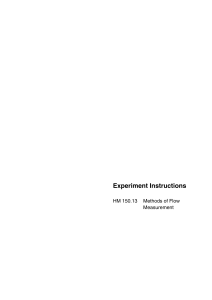6.153 area of 1 ft , are connected by a 0.5-in-
advertisement
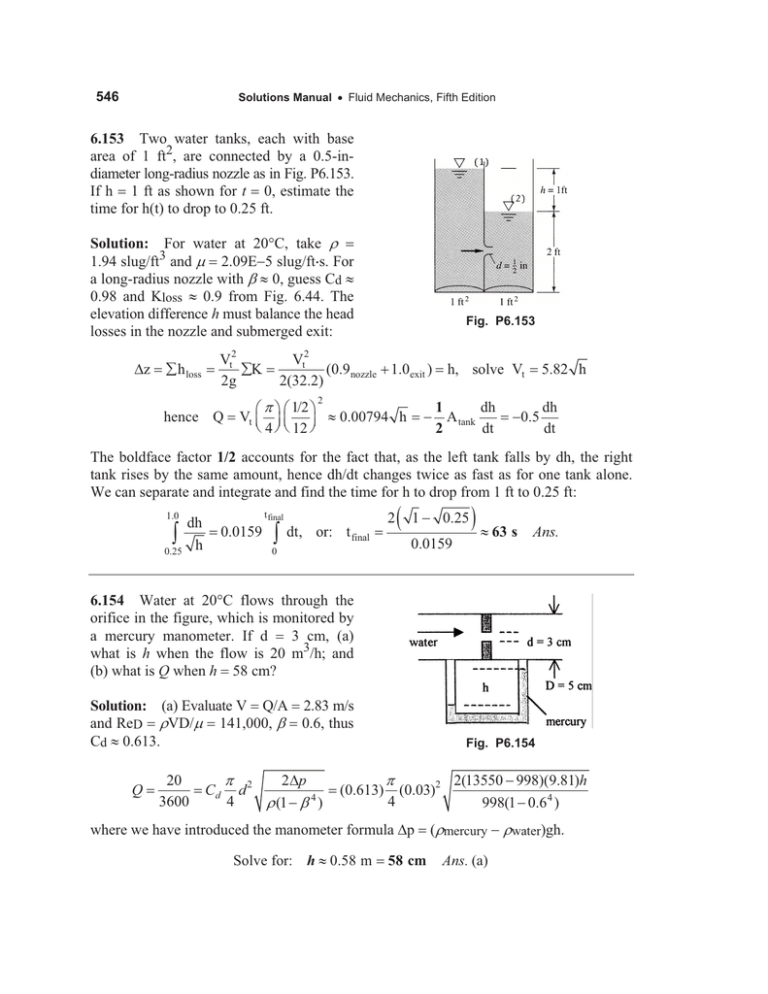
546 Solutions Manual x Fluid Mechanics, Fifth Edition 6.153 Two water tanks, each with base area of 1 ft2, are connected by a 0.5-indiameter long-radius nozzle as in Fig. P6.153. If h 1 ft as shown for t 0, estimate the time for h(t) to drop to 0.25 ft. Solution: For water at 20qC, take U 1.94 slug/ft3 and P 2.09E5 slug/fts. For a long-radius nozzle with E | 0, guess Cd | 0.98 and Kloss | 0.9 from Fig. 6.44. The elevation difference h must balance the head losses in the nozzle and submerged exit: 'z ¦ h loss Vt2 ¦K 2g Fig. P6.153 Vt2 (0.9nozzle 1.0exit ) 2(32.2) 2 § S · § 1/2 · Vt ¨ ¸ ¨ ¸ | 0.00794 h © 4 ¹ © 12 ¹ hence Q h, solve Vt 1 dh A tank dt 2 5.82 h 0.5 dh dt The boldface factor 1/2 accounts for the fact that, as the left tank falls by dh, the right tank rises by the same amount, hence dhdt changes twice as fast as for one tank alone. We can separate and integrate and find the time for h to drop from 1 ft to 0.25 ft: 1.0 ³ t final dh 0.25 0.0159 h ³ 2 dt, or: t final 1 0.25 0.0159 0 | 63 s Ans. 6.154 Water at 20qC flows through the orifice in the figure, which is monitored by a mercury manometer. If d 3 cm, (a) what is h when the flow is 20 m3h; and (b) what is Q when h 58 cm? Solution: (a) Evaluate V QA 2.83 m/s and ReD UVDP 141,000, E 0.6, thus Cd | 0.613. Q 20 3600 Cd S 4 d2 2'p U (1 E 4 ) (0.613) Fig. P6.154 S 4 (0.03)2 where we have introduced the manometer formula 'p Solve for: h | 0.58 m 58 cm 2(13550 998)(9.81)h 998(1 0.6 4 ) (Umercury Uwater)gh. Ans. (a) 547 Chapter 6 x Viscous Flow in Ducts Solve this problem when h 58 cm is known and Q is the unknown. Well, we can see that the numbers are the same as part (a), and the solution is Solve for: Q | 0.00556 m 3 /s 20 m 3 /h Ans. (b) 6.155 It is desired to meter a flow of 20qC gasoline in a 12-cm-diameter pipe, using a modern venturi nozzle. In order for international standards to be valid (Fig. 6.40), what is the permissible range of (a) flow rates, (b) nozzle diameters, and (c) pressure drops? (d) For the highest pressure-drop condition, would compressibility be a problem? Solution: For gasoline at 20qC, take U 680 kg/m3 and P the possible range of Reynolds number and beta ratio: 1.5E5 Re D 4UQ SP D 4(680)Q 2.0E5, S (2.92E4)(0.12) or 0.0061 Q 0.0081 0.316 E 2.92E4 kg/ms. Examine m3 s Ans. (a) d/D 0.775, or: 3.8 d 9.3 cm Ans. (b) For estimating pressure drop, first compute Cd(E) from Eq. (6.116): 0.924 Cd 0.985: 2 ª Q º Q Cd (0.12E ) 2.66E6(1 E ) « 2» 4 ¬ Cd E ¼ put in large Q, small E, etc. to obtain the range 200 'p 18000 Pa Ans. (c) S 2 2 'p , or: 'p 680(1 E 4 ) 4 6.156 Ethanol at 20qC flows down through a modern venturi nozzle as in Fig. P6.156. If the mercury manometer reading is 4 in, as shown, estimate the flow rate, in gal/min. Solution: For ethanol at 20qC, take U 2.51E5 slug/fts. 1.53 slug/ft3 and P Given E 0.5, the discharge coefficient is Cd 0.9858 0.196(0.5)4.5 | 0.9771 Fig. P6.156
